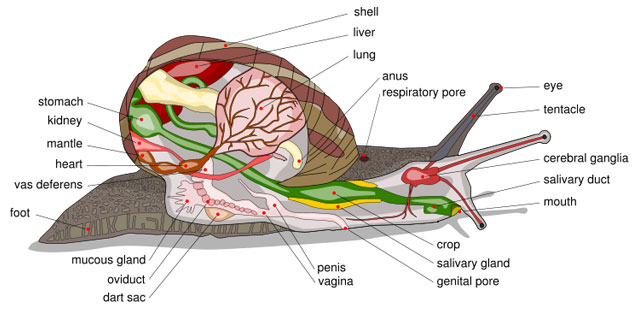Reproduction
In the family Lymnaeidae, all species are hermaphrodites or monoecious, meaning they have both male and female sex organs. They can either self-fertilize, cross-fertilize (meaning they both act as male and female and exchange their sperm), or exhibit protandry (Martin, 1999). Protandry means that males are produced before females. The snail will produce sperm then later produce eggs. Even though the snails are monoecious, the most common reproduction style is cross-fertilization (this maintains genetic diversity within the population) Copulation is a common type of reproduction for many Gastropods including Stagnicola elodes. Lymnaeids lay their eggs in long masses, complete their larva stage within the egg, and then come out of the egg as miniature snails with complete shell (University of Michigan, 2008).
The strategy of copulation, used by Stagnicola
elodes, was researched by Paul H. Rudolph to better
understand the mating mechanism of this snail. Copulation is a
complex mating style with several steps. Rudolph first observed
the male climbing on top of the female's shell and wandering
about until he found a desirable position close to the right
margin of the shell (Rudolph, 1979). Then the male's gonopore enlarges and his
penial complex everts. The male snail probes the female under
its shell until he inserts his penis into the female gonopore (Rudolph, 1979).
The male is tightly attached to the female's shell during this time,
and the female does not change her
behavior; she continues to move and feed (Rudolph, 1979). However, once the male
inserts into the female gonopore, the female withdrawals
partially into the shell (Rudolph, 1979). The withdrawal is temporary and
copulation continues once she returns out (Rudolph, 1979).
After approximately 90 minutes of copulation, reciprocation takes
place (Rudolph, 1979). This means that the female, with the male still tightly
attached and penis still inserted in the gonopore, moves her
body around until she is aligned to his shell at the right
anterior margin. The female then takes on the male role and
begins probing with its penis. Once the new acting male inserts
its penis into the gonopore, the male's penis is no longer in
the female vagina (Rudolph, 1979). Copulation again occurs, only with the snails
in opposite positions. Once copulation is complete, the pair of
snails separate and the original male cannot recopulate (Rudolph, 1979).
Rudolph's results showed that the original female, previously acting as
the male, has the ability to recopulate with another snail,
which is known as chain copulation (Rudolph, 1979). During copulation, all of
the male's sperm is ejaculated into the female. In the
Stagnicola eldoes, a copulatory plug is not needed because
its gonopore region is highly muscularized to prevent leakage of
the sperm. In other species, a plug, also known as a
spermatophore, forms to hold the penis in place during
copulation and to prevent sperm leakage following copulation
(Rudolph, 1979).
Copulation can occur in various types. The main type of copulation is sexual intercourse between two
snails. Another type is called unilateral copulation, where one acts
only as a male and the other only as a female. Unilateral
copulation occurs in chain copulation (Rudolph, 1979).
Rudolph showed that
chain copulation occurred through 5 snails in his study, all with the female
assuming the males position on the next snail(Rudolph, 1979). The third type is
known as reciprocal copulation. This type means that both snails
assume both roles (Rudolph, 1979).
Although Lymnaeidae species have many options for reproduction,
it has been observed by many researchers, including Rudolph and
Martin, copulation is commonly practiced. This method is a type
of cross-fertilization, which provides genetic diversity in the
offspring, in addition the various styles of copulation can
benefit multiple individuals by many snails reproducing at one
time.
